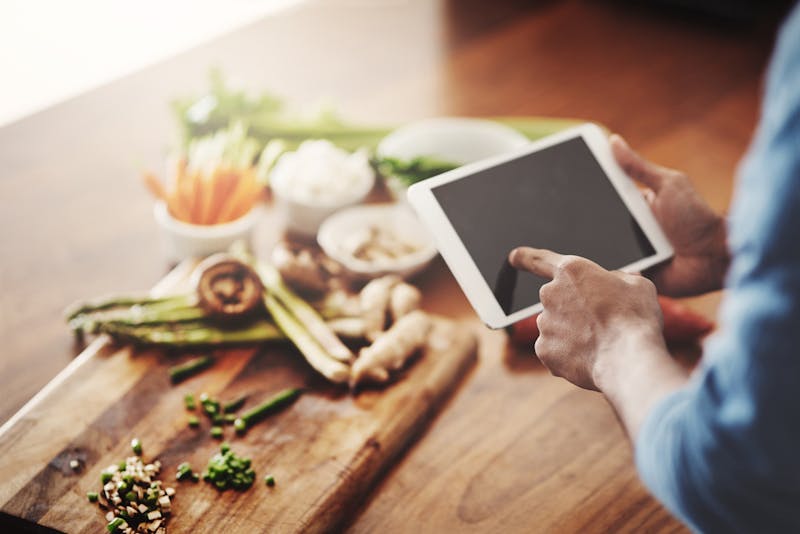
Wearable devices, wellness apps, health monitors, and fitness trackers support personalized and proactive well-being. They provide quantifiable metrics and goal-oriented reminders to help you stay on track. Many products leverage machine learning to tailor your experience and predict how to keep you motivated.
Health and wellness technology doesn’t replace the need for traditional medicine, diagnosis, or treatment. They empower you with tools and information. In many cases, the data provided helps healthcare practitioners create tailored treatment plans.
What to look for in wearable technology and wellness apps?
Wearables and wellness apps are in their infancy. Some invest more time and money in their algorithms and scientific research, while others get to market as fast as they can. It takes time for laws and regulations to catch up with technological advances. So, determine how your data is secured and if your data is shared with third-party sources.
Privacy and data security
Before you purchase a wearable device or download a health or wellness app, ensure you understand their privacy standards. If the app is for personal use, including nutrition and fitness apps, it doesn’t have to have HIPPA-level patient privacy. If your device is FDA-approved, its data storage and software must be HIPPA-compliant. Many health and wellness apps go the extra mile and build in HIPPA-level data security and data privacy.
Features, functions, and goal-oriented
If this is your first time using health and wellness technology, you may be unsure of what to expect. Review the app or website and dive into its features and functions to determine if they support your goals. Review what kind of metrics are provided, what is tracked, and how metrics are visualized in reports. If you plan to use multiple apps and devices, ensure their data integrates.
Reputation
Before you invest, learn what other users are saying. Ask friends, family, and healthcare professionals. Also, head online and read consumer reviews. Focus on both the positives and the negatives. This will help you choose health and wellness technology that meets your needs.
Ease of use
Your device and apps should be easy to use. The app dashboards and reports should be intuitive. Consider if you want to share or download your data with your physician and explore how easily data is shared. Post-purchase, complete all software updates to maintain security and access new features and functions.
Top Health and Wellness Technology
Think beyond the advances in telehealth and the improved accessibility to your physician and health records to the technology, wearables, and apps below. Some are physician-suggested, and others are investments you can use to tailor your wellness journey.
#1 Smart Rings
Smart rings are an excellent alternative for those who don’t like smartwatches, don’t wear watches, or prefer a traditional watch. They track many of the same metrics as smartwatches without the communication features. Some have FDA clearance for tracking irregular heartbeats and other health metrics, but they don’t replace the need for traditional healthcare.
Smart rings and smartwatches track any combination of:
- Physical activity: Steps walked, distance traveled, elevation, workout duration, and calories burned.
- Activity-specific performance: Workout-specific metrics for walking, running, cycling, swimming, and other activities.
- Sleep quality: Sleep patterns, sleep stages, and sleep duration to help improve your sleep.
- Health metrics: Heart rate, heart rhythm, blood oxygen levels, blood pressure, skin temperature, and stress risk factors.
#2 Smartwatches
Smartwatches fall into 2 primary categories: watches with activity tracking and multi-purpose devices with smartphone capabilities. The advantage of activity and fitness trackers, including Fitbit, is that they tend to be smaller and sleeker than smartwatches. However, smartwatches have internet and full communication features.
In terms of tracking, most watches and their accompanying apps have similar functions. You may decide which is right for you solely by your preferred technology (iOS vs. Android). In addition to the brand app, ensure it integrates with all your health apps.
Just like smart rings, some smartwatches have FDA clearance for specific health tracking functions.
#3 Condition-specific wearables
Some health and wellness technology monitors diabetes or other health conditions.
Diabetic monitoring
Continuous glucose monitoring devices streamline and simplify diabetic management, improving the quality of life for those living with diabetes. Many sync to apps that provide proactive reminders and real-time alerts for the patient and physician.
Auditory technology
Due to the combination of earbud and headphone use and the increasingly loud sounds of modern life, hearing loss is developing at younger ages. Using a sound decibel app is one way to take a proactive approach to maintaining hearing for kids and adults.
There’s a new generation of hearing technology that’s transforming communication for those with mild, moderate, and significant hearing loss. This includes the FDA approval of AirPods Pro 2 as sound-amplifying hearing aids. While AirPods are cost-effective, audiologist-prescribed hearing aids, cochlear implants, and technology provide the most advanced features.
This includes any combination of:
- Directional microphones
- Environment-specific noise filtering
- Bluetooth connectivity
- Integration with caption apps
- AI sound detection
- Amplifying those you engage with most
- Wind and weather filtering
- And more!
#4 Meal and nutrition planning apps
There is a range of meal-planning apps that serve a variety of purposes. Some are geared toward saving time and money, while others are geared toward weight loss and health objectives. In addition to simplifying meal planning, these apps can minimize food waste while introducing new recipes so that meals don’t get monotonous.
Many allow you to add your own recipes and automate your grocery shopping lists by the recipes you select for the week ahead.
Don’t forget, diets don’t work!
Deprivation should never be the objective of utilizing health and wellness technology for nutrition. Meals should be centered around nutrient-dense foods that keep you energized physically and mentally, even when reducing your daily caloric intake.
- Recipe apps: Apps like Big Oven have recipes of every kind. From casual to gourmet, healthy to indulgent. The objective is more to meal plan than to meet nutritional objectives.
- Goal-specific: These apps formulate meal plans to lose weight, maintain weight loss, build muscle mass, improve endurance, train for a marathon, or achieve other health and fitness objectives. Provide your target calories, fat, protein, carbs, and grams of sugar, and these apps populate aligned recipes.
- Nutrition-specific: If you have a food allergy, are diabetic and need low-glycemic index recipes, or want to follow a nutrient-dense meal plan (Mediterranean, keto, Paleo), these apps personalize your meals to your dietary needs.
- Restaurant locators: These apps are excellent if you don’t like to cook or want to identify healthy meals while traveling. They suggest nutrient-dense meals at specific restaurants and the healthiest options in nearby restaurants.
What are positive-psychology reminders?
Positive-psychology reminders are goal-specific motivation designed to uplift and engage you throughout the day. They aren’t the standard health and wellness reminders that you’re low on steps.
Positive-psychology reminders:
- Focus on your strengths
- Celebrate your success
- Promote well-being
- Promote positive emotions
- Provide meaning and purpose
- Develop and nurture healthy habits
#5 AI meal planning
One of the many ways you can utilize artificial intelligence is for meal planning. All you need is Google Gemini or your preferred AI chatbot. Be mindful that AI results aren’t 100%. The more specific you are with your prompts, the better your results.
Below are 2 of the top ways to utilize AI for meal planning:
- When you aren’t sure what to make with the ingredients you have at home, type your ingredients into a chatbot, and it will create a recipe for you. Don’t forget to include herbs, spices, lemon, lime, and even grains, noodles, and cooking oils.
- Provide a prompt that includes your desired calories, fat, protein, carbs, grams of sugar, food preferences, and food allergies. Then, ask AI to create breakfasts, lunch, dinner, snacks, and a grocery shopping list for a single meal or a set number of meals.
#6 Fitness apps
Fitness apps are a rapidly growing segment of health and wellness technology. They eliminate the guesswork of what to do when working out at home. Like goal-specific and meal planning apps, many utilize positive psychology to help you stay on track. Most tailor their workouts to your goals, including weight loss, weight maintenance, endurance, toning, and strengthening. Some apps utilize gamification and have community features to keep things fun.
Use when traveling, when you can’t make it to the gym, or as your go-to workout.
What’s the advantage of fitness apps versus YouTube workouts?
YouTube offers a diverse range of workouts, so you may be wondering how apps are of benefit. The primary advantage of apps is that they have options for personalizing your workout. For example, creating workouts that won’t irritate areas of injury, such as chronic knee or back pain.
You may prefer a mix of apps, YouTube, and online subscriptions to keep things fun.
#7 Holistic health apps
Apps geared toward improving mental health and the quality of your sleep are the most popular types of holistic health apps. Calm and Headspace are top picks for personalizing holistic health.
Holistic health apps may include any combination of:
- Sleep stories
- Guided meditations
- Timed meditations
- Mindfulness lessons
- Sound therapy/mood music
- Goal-oriented reminders
How can Valley Medical help personalize your wellness journey?
In addition to the health and wellness technology above, Valley Medical Weight Loss and Med Spa helps you personalize your wellness journey. From confidence-boosting aesthetic treatments to wellness injections, premium vitamins, meal replacement shakes, weekly weight loss plans, GLP-1, hormone replacement therapy for women and men, and more.
Schedule a consultation in our Phoenix, Tempe, or Glendale office to learn more!

